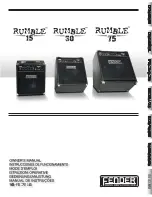
2) The characteristic of gain devices and their specific use is important. Individual
variations in performance between like devices is important, as are differences in topological
usage. All signal bearing devices contribute to the degradation, but there are some different
characteristics are worth attention. Low order nonlinearities are largely additive in quality,
bringing false warmth and coloration, while abrupt high order nonlinearities are additive and
subtractive, adding harshness while losing information.
3) Maximum intrinsic linearity is desired. This is the performance of the gain stages before
feedback is applied. Experience suggests that feedback is a subtractive process; it removes
information from the signal. In many older designs, poor intrinsic linearity has been
corrected out by large application of feedback, resulting in loss of warmth, space, and detail.
High idle current, or bias, is very desirable as a means of maximizing linearity, and gives an
effect which is not only easily measured, but easily demonstrated: Take a Class A or other
high bias amplifier and compare the sound with full bias and with bias reduced. (Bias
adjustment is easily accomplished, as virtually every amplifier has a bias adjustment pot, but
it should be done very carefully). As an experiment it has the virtue of only changing the
bias and the expectations of the experimenter.
As the bias is reduced the perception of stage depth and ambiance will generally decrease.
This perception of depth is influenced by the raw quantity of bias current.
If you continue to increase the bias current far beyond the operating point, it appears that
improvements are made with bias currents which are much greater than the signal level.
Typically the levels involved in most critical listening are only a few watts, but an amplifier
biased for ten times that amount will generally sound better than one biased for the few
watts.
For this reason, designs which operate in what has been referred to as "pure" Class A are
preferred because their bias currents are much larger than the signal most of the time.
As mentioned, preamp gain stages and the front ends of power amplifiers are routinely
single ended "pure" Class A, and because the signal levels are at small fractions of a watt,
the efficiency of the circuit is not important.
Problems with push-pull amplifier designs associated with crossover distortion have been
discussed elsewhere at length, and one of the primary results is non-monotonicity. Class B
and many AB designs have distortion products that dramatically increase with decreasing
signal. This is reduced greatly by Class A mode, but crossover distortion remains as a
lower order discontinuity in the transfer curve.
A very important consideration in attempting to create an amplifier with a natural
characteristic is the selection of the gain devices. A single ended Class A topology is
appropriate, and we want a characteristic where the positive amplitude is very, very slightly
greater than the negative. For a current gain device, that would mean gain that smoothly
increases with current, and for a tube or field effect device a transconductance that smoothly
increases with current.
Содержание Aleph P
Страница 1: ...Pass Laboratories Aleph P Owner s Manual...




























